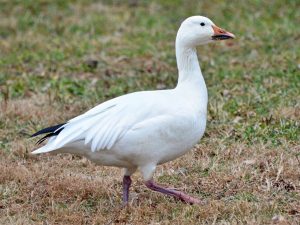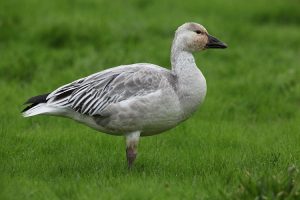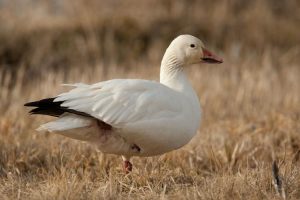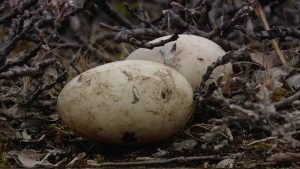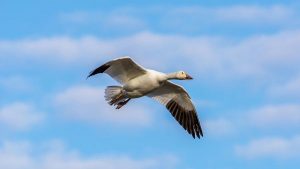Snow Goose
The migratory bird is known for its snow-like color that gets it’s the name. There are usually two color morphs of the species and the birds belonging to different morphs often crossbreed with each other. The otherwise carnivorous bird sometimes consumes larvae of flies during its initial days post-hatching.
Scientific Classification
| Kingdom | Animalia |
| Phylum | Chordata |
| Class | Aves |
| Order | Anseriformes |
| Family | Anatidae |
| Genus | Anser |
| Scientific Name | Anser caerulescens |
Quick Information
| Description | Size: 27-33 in (68.58-83.82 cm) Weight: 88.18-158.73 oz ( 2.5-4.5 kg) Wingspan: Around 54 in (4.5 ft) Color: Two morphs are visible, one is white and the other is blue. Both morphs are named after their plumage color |
| Distribution | Canada, Mexico, the United States, and Greenland, |
| Habitat | Wet grasslands, coastal marshes, fields, bays, and tundra |
| Subspecies | 1. c. caerulescens or lesser snow goose 2. c. atlanticus or greater snow goose |
| Sounds & Communication | Honk like one-syllable noise, a throaty voice when families communicate with each other, shrill sounds when in flight |
| Lifespan | Around 15 years |
| Diet | Shrubs, grasses, willows, seeds, roots, stems, fruits, and fly larvae |
| Adaptations | Their feather are indicators of the weather and when they become cool, the birds start migrating |
| Predators | Wolves, foxes, golden and bald eagles, and polar bears |
| IUCN Conservation Status | Least Concern |
Behavior
- While migrating to the south for the winter season, the entire flock makes a shape of v in the sky.
- Their roosting time is during the night being afloat.
- They have the capacity to sleep while swimming.
Mating and Reproduction
Post winter, snow geese return to the north and adult ones look for mates. They try to find their counterparts similar to their parents’ coloration, although this is not the case always. Nesting is typically observed at the end of May. Females lay 2-6 eggs followed by an incubation period of 22-25 days.
Life-cycle
Hatchlings are usually covered with down and their eyes are open. They become able to eat and swim without any help within 24 hours of birth and after 42-50 days, they start flying. Despite their ability, they are supervised and kept under the protection of their parents for another 2-3 years.
Interesting Facts
- Previously, the two morphs, white and blue were considered different species.
- Due to their overpopulation at some places, they have become the reason of the destruction of their own habitat.
- They fly so high during the migration that it becomes difficult to spot them.
References
- https://www.nationalgeographic.com/animals/birds/facts/snow-goose
- https://www.allaboutbirds.org/guide/Snow_Goose/lifehistory
- https://www.audubon.org/field-guide/bird/snow-goose
- https://www.britannica.com/animal/snow-goose
Published on May 15th 2019 by Sahana Kanjilal under Coniferous Forest Animals.
Article was last reviewed on 5th December 2024.


